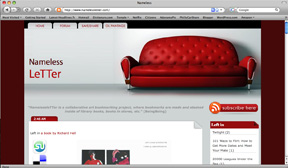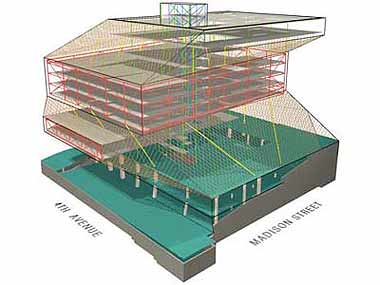I’ve been digging around the internet in search of artists’ projects that involve books and libraries. I came across Nameless LeTTers, “a collaborative art project where people from all horizons leave personalized bookmarks in books with the goal of seeing other readers discover them.” The process is simple– make a bookmark, scan it and send a copy to the website, then place the bookmark in a book somewhere out in the public realm. The project’s creator/s have chosen to remain anonymous, handing the reins over to voluntary participants across the globe.
I’m attracted to the simplicity of the project, but I wish there was a traceable connection between books, participants, locations…… something. The gesture doesn’t seem to extend beyond the creation and documentation of the bookmark. Who, for example, is going to find these isolated bookmarks? Will the finder notify the webiste when a bookmark has been located? Will they place it in another book for someone else to find? What , if any, are developing between users, books and locations? One such pattern, emphasized by the format of the website, is the fact that several people have chosen to create bookmarks for the same book. In the Public Author project, I’m beginning to think of individual books as magnets for tags. Some books are more attractive than others to begin with, but then there is the idea of popularity. Once somebody has drawn attention to a particular book, others will follow.
The Nameless LeTTer site has a simple structure. You can search for bookmarks in two ways. First, by scrolling through a menu of book titles for which bookmarks have been created. Secondly, by interacting with a google map of locations where bookmarks have been deposited. The list of book titles leads to an image of each bookmark, while the google map is restricted to names of locations.
The Public Author’s site will have a similar structure. Th site’s main page will be a running list of individual book titles. Connected to each title will be user-generated tags and a keyword denoting the location from which the tags were sent. Books will only exist on our website if they have been tagged by a library user. I would also like to incorporate an interactive map which would provide an alternative means of browsing the site. The map would allow you to view all of the books that have been tagged from a particular location. Simple enough. But beyond this initial framework I am interested in detecting and presenting various patterns that will emerge from the intersection of these three elements: books, users, locations. For example, the book “Twilight” has been tagged by several users, resulting in several appearances of the book title on our site. How can we map this popularity to create connections between users in various locations? Ultimately, I think that we need to present a third means of accessing the information, perhaps a hybrid view that compiles locations with book titles.



